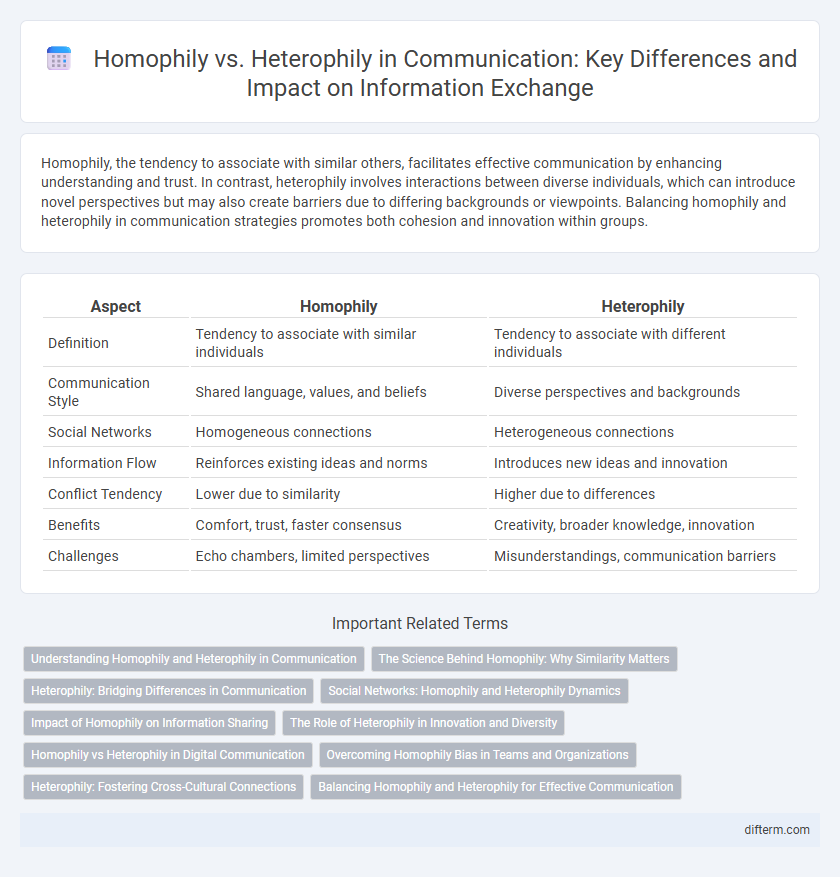Homophily, the tendency to associate with similar others, facilitates effective communication by enhancing understanding and trust. In contrast, heterophily involves interactions between diverse individuals, which can introduce novel perspectives but may also create barriers due to differing backgrounds or viewpoints. Balancing homophily and heterophily in communication strategies promotes both cohesion and innovation within groups.
Table of Comparison
| Aspect | Homophily | Heterophily |
|---|---|---|
| Definition | Tendency to associate with similar individuals | Tendency to associate with different individuals |
| Communication Style | Shared language, values, and beliefs | Diverse perspectives and backgrounds |
| Social Networks | Homogeneous connections | Heterogeneous connections |
| Information Flow | Reinforces existing ideas and norms | Introduces new ideas and innovation |
| Conflict Tendency | Lower due to similarity | Higher due to differences |
| Benefits | Comfort, trust, faster consensus | Creativity, broader knowledge, innovation |
| Challenges | Echo chambers, limited perspectives | Misunderstandings, communication barriers |
Understanding Homophily and Heterophily in Communication
Homophily in communication refers to the tendency of individuals to associate and bond with others who share similar characteristics, beliefs, or values, enhancing message clarity and trust. Heterophily, by contrast, involves interaction between individuals with differing attributes, which can introduce diverse perspectives but may require more effort to overcome communication barriers. Understanding these dynamics is crucial for effectively tailoring communication strategies to foster connection or innovation within groups.
The Science Behind Homophily: Why Similarity Matters
Homophily, the tendency for individuals to associate with others who share similar characteristics, plays a crucial role in communication by enhancing message clarity and reducing misunderstandings. Research shows that shared values, beliefs, and backgrounds foster trust and facilitate smoother information exchange in social networks. This principle explains why people often prefer interacting within homogeneous groups, as similarity promotes effective collaboration and social cohesion.
Heterophily: Bridging Differences in Communication
Heterophily in communication involves interacting with individuals who differ significantly in beliefs, values, or backgrounds, fostering diverse perspectives and innovative ideas. This bridging of differences enhances problem-solving and creativity by integrating varied experiences and knowledge. Effective heterophilous communication promotes understanding and collaboration across social, cultural, and professional divides.
Social Networks: Homophily and Heterophily Dynamics
Social networks exhibit homophily when individuals connect with others who share similar characteristics, beliefs, or interests, reinforcing shared norms and facilitating efficient information exchange. In contrast, heterophily promotes interaction between diverse individuals, fostering innovation and access to novel ideas by bridging structural holes within the network. Understanding the balance between homophily and heterophily dynamics is crucial for optimizing information diffusion and social cohesion in digital and offline communities.
Impact of Homophily on Information Sharing
Homophily significantly enhances information sharing by fostering trust and mutual understanding among similar individuals, leading to faster and more efficient communication. Networks characterized by homophily often experience reinforced shared knowledge, yet this can limit exposure to diverse perspectives and innovative ideas. The impact of homophily in communication highlights a balance between cohesive information flow and the risk of echo chambers within social networks.
The Role of Heterophily in Innovation and Diversity
Heterophily enhances innovation and diversity by fostering connections between individuals with different backgrounds, perspectives, and knowledge bases. This diversity of ideas accelerates problem-solving and creative thinking, leading to groundbreaking solutions and cultural enrichment. Organizations embracing heterophilous communication networks experience increased adaptability and competitive advantage in dynamic markets.
Homophily vs Heterophily in Digital Communication
Homophily in digital communication refers to the tendency of individuals to connect and share information with others who have similar interests, beliefs, or backgrounds, leading to echo chambers and reinforcement of existing viewpoints. Heterophily, on the other hand, promotes interactions between diverse individuals, facilitating exposure to new ideas and fostering innovation across different social or cultural groups. Platforms that encourage heterophily can enhance digital communication by breaking down algorithmic filters, creating more inclusive and dynamic online environments.
Overcoming Homophily Bias in Teams and Organizations
Overcoming homophily bias in teams and organizations requires intentional strategies that promote diversity and inclusion, such as cross-functional collaboration and structured networking opportunities. Implementing training programs that raise awareness of unconscious biases helps team members appreciate heterophily, which enhances creativity and problem-solving by integrating diverse perspectives. Leveraging digital communication tools to connect individuals across different backgrounds further reduces the effects of homophily and fosters innovation within organizational culture.
Heterophily: Fostering Cross-Cultural Connections
Heterophily facilitates cross-cultural communication by bridging diverse social groups and encouraging the exchange of novel ideas and perspectives. This concept enhances innovation and problem-solving by connecting individuals with different backgrounds, beliefs, and experiences. Emphasizing heterophily in communication strategies promotes inclusivity and broadens networks beyond homogenous circles.
Balancing Homophily and Heterophily for Effective Communication
Balancing homophily and heterophily enhances communication effectiveness by combining shared understanding with diverse perspectives. Homophily fosters trust and empathy through common experiences, while heterophily introduces novel ideas and broader knowledge. Optimal communication strategies integrate both elements to facilitate collaboration, innovation, and problem-solving across varied social and professional networks.
homophily vs heterophily Infographic

 difterm.com
difterm.com